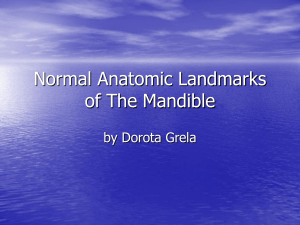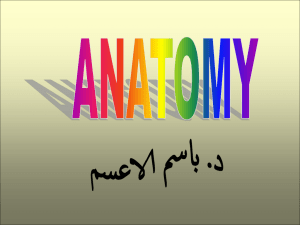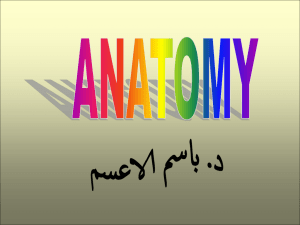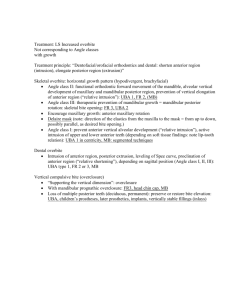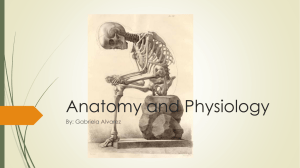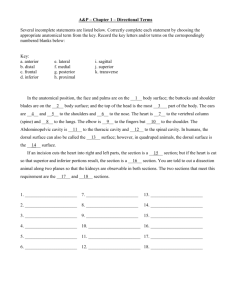Document 12837768
advertisement
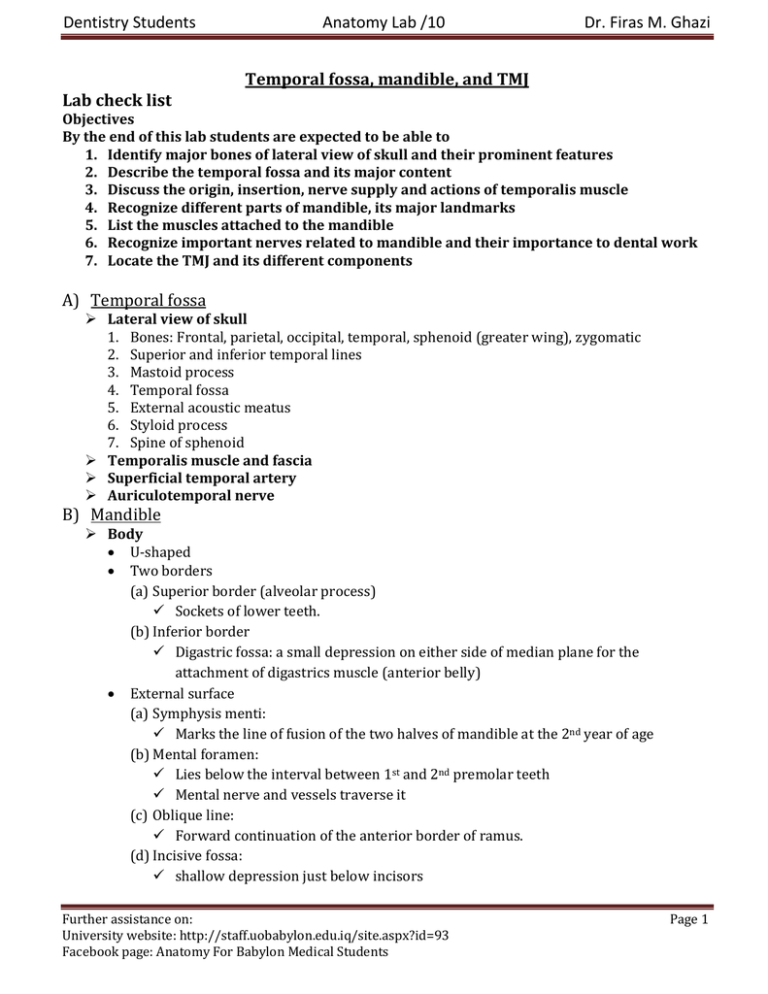
Dentistry Students Anatomy Lab /10 Dr. Firas M. Ghazi Temporal fossa, mandible, and TMJ Lab check list Objectives By the end of this lab students are expected to be able to 1. Identify major bones of lateral view of skull and their prominent features 2. Describe the temporal fossa and its major content 3. Discuss the origin, insertion, nerve supply and actions of temporalis muscle 4. Recognize different parts of mandible, its major landmarks 5. List the muscles attached to the mandible 6. Recognize important nerves related to mandible and their importance to dental work 7. Locate the TMJ and its different components A) Temporal fossa Lateral view of skull 1. Bones: Frontal, parietal, occipital, temporal, sphenoid (greater wing), zygomatic 2. Superior and inferior temporal lines 3. Mastoid process 4. Temporal fossa 5. External acoustic meatus 6. Styloid process 7. Spine of sphenoid Temporalis muscle and fascia Superficial temporal artery Auriculotemporal nerve B) Mandible Body U-shaped Two borders (a) Superior border (alveolar process) Sockets of lower teeth. (b) Inferior border Digastric fossa: a small depression on either side of median plane for the attachment of digastrics muscle (anterior belly) External surface (a) Symphysis menti: Marks the line of fusion of the two halves of mandible at the 2nd year of age (b) Mental foramen: Lies below the interval between 1st and 2nd premolar teeth Mental nerve and vessels traverse it (c) Oblique line: Forward continuation of the anterior border of ramus. (d) Incisive fossa: shallow depression just below incisors Further assistance on: University website: http://staff.uobabylon.edu.iq/site.aspx?id=93 Facebook page: Anatomy For Babylon Medical Students Page 1 Dentistry Students Anatomy Lab /10 Dr. Firas M. Ghazi Internal surface (a) Genial tubercles (mental spines): At the inner aspect of symphysis menti Four tubercles arranged into two pairs (upper and lower) Genioglossus muscles attached to the upper tubercles Geniohyoid muscles attached to the lower pair (b) Mylohyoid line: A prominent oblique ridge Runs obliquely downwards and forwards From behind 3rd molar tooth (1 cm below the alveolar border) to symphysis menti below genial tubercles. (c) Sublingual fossa: Shallow area above the anterior part of the mylohyoid line and lodges sublingual gland (d) Mylohyoid groove: Starts at the ramus just below the mandibular foramen Below the posterior part of mylohyoid line. Mylohyoid nerve and vessels run in this groove. (e) Submandibular fossa: Below the posterior part of mylohyoid line Lodges submandibular gland. Muscles attached 1. Platysma: inferior border 2. Anterior belly of digastrics: digastric fossa 3. Buccinator: oblique line below molar teeth 4. Genioglossus: superior genial tubercle 5. Geniohyoid: inferior genial tubercle 6. Mylohyoid: mylohyoid line 7. Superior constrictor: area above the posterior end of mylohyoid line. Ramus (right and left) Projects upwards from the posterior end of the body Borders (a) Superior (mandibular notch) (b) Inferior (c)Anterior (d)Posterior Angle of mandible: meeting point between posterior and inferior borders Two processes (a) Condylar process: Projects upward from the posterior end of mandibular notch Head: above Neck: below Pterygoid fovea: a depression on the anterior surface of the neck Further assistance on: University website: http://staff.uobabylon.edu.iq/site.aspx?id=93 Facebook page: Anatomy For Babylon Medical Students Page 2 Dentistry Students Anatomy Lab /10 Dr. Firas M. Ghazi (b) Coronoid process: Projects upward from the anterior end of mandibular notch Lateral surface Medial surface (a) Mandibular foramen: Leads into mandibular canal which runs downwards and forwards into the body to open on its external surface as mental foramen. Provides passage to: 1) Inferior alveolar nerve: posterior division of mandibular nerve 2) Inferior alveolar artery: 1st part of maxillary artery 3) Inferior alveolar vein. (b) Lingula A small project on the anterior margin of mandibular foramen. Muscles attached 1. Masseter: lateral surface 2. Temporalis: coronoid process 3. Lateral pterygoid: pterygoid fovea 4. Medial pterygoid: inner surface/above the angle Ligaments Attached 1. Temporomandibular: lateral aspect of the neck 2. Sphenomandibular: lingula 3. Stylomandibular: angle of mandible 4. Pterygomandibular raphe: behind and medial to the root of last molar Nerves Related to Mandible 1. Auriculotemporal: medial side of the neck. 2. Masseteric: through mandibular notch/to masseter 3. Inferior alveolar: mandibular foramen/mandibular canal/to lower teeth 4. Mylohyoid: mylohyoid groove/to mylohyoid muscle 5. Lingual: medial to root of 3rd molar/to anterior 2:3rd of tongue 6. Mental: mental foramen 7. Marginal mandibular: across the lower border of the mandible. C) Temporomandibular joint Articular Surfaces 1. Mandibular (Glenoid) fossa 2. Articular eminence 3. head of mandible Capsule Articular disc Further assistance on: University website: http://staff.uobabylon.edu.iq/site.aspx?id=93 Facebook page: Anatomy For Babylon Medical Students Page 3
